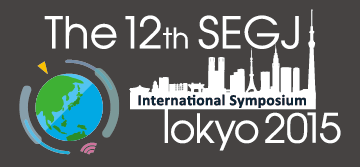The 12th Society of Exploration Geophysicists of Japan International Symposium
2F MK5 Bldg., 1-5-6 Higashikanda, Chiyoda-ku, Tokyo, 101-0031, Japan
The 12th SEGJ International Symposium
Final Program
Instructions for Authors
- Language
The official language of the Symposium is English. - Oral Presentations
Oral presentations should be 15 minutes in length with 5 additional minutes allotted to each presenter for questions. A set of PC and LCD projector is available for presentation. The staff helps you to copy your Power Point file to the provided PC before your session starts. CD-ROMs and USB thumb drives are available. Checking your file preceding your presentation is strongly recommended. In case you use your own PC, an auxiliary cable and a display switch is provided. Be sure to connect your PC before your presentation time starts. - Poster Presentations
The poster panel of 90 cm in width and 200 cm in height are arranged in the poster presentation room. Put your posters on the panel under your presentation ID label at least before the poster core time. All the presenters are required to stay in front of their posters during the core time. Materials needed to put the posters onto the boards are available in the room. The posters should be displayed during the symposium, from 18th to 20th and should be removed by 13:00, 20th.
Extended Abstract submission
Prospective authors are cordially invited to electronically submit original extended abstracts (including figures) with up to four pages for publication in the symposium proceedings which are electronically distributed to all participants on USB keys. All Expanded abstracts will be subject to a review process to judge the quality. Download an "Template (MS-WORD) containing the instruction for preparation of camera-ready extended abstract"
Deadline of submission (extended): July 3, 2015 (Closed).
[Notification of Acceptance / Rejection]
The Symposium Technical Program Committee will make the final decision on acceptance/rejection of extended abstracts. Notification of acceptance/rejection will be sent by email by the end of July, 2015.
Copyright Transfer
In consideration of the publication of the above paper in the Proceedings
of SEGJ International Symposium, the author(s) hereby grant non-exclusive
rights to the Society of Exploration Geophysicists of Japan to publish
that paper throughout the world in any format and via any mechanism (including
transmission over the internet and other communications networks, and in
any other electronic/digital form) and non-exclusive rights to deal with
requests from third parties. The author(s) hereby warrant that the Work
is original and that he/she is the author of the Work; to the extent the
Work incorporates text passages, figures, data or other material from the
works of others, the undersigned has obtained any necessary permissions.
Electronic Copyright Transfer should be submitted after receiving the notification
of acceptance.
Best Presentation Award
The Best Presentation Award will be given to the author(s) who are considered to have made the most significant contribution to the advancement of applied geophysics. Furthermore, to encourage students in applied geophysics, the Best Student Presentation Award will be given to two full-time students who have made excellent oral or poster presentations at the symposium.Symposium Schedule (Planned)
- Tuesday, 17 November EAGE Education Tour (EET)
Satellite InSAR Data: Reservoir Monitoring from Space (Course Description)
Instructor: Alessandro Ferretti (Tele-Rilevamento Europa - Milan, Italy) - 18 November (Wed): Opening Remarks, Key note presentation, Technical Session, Welcome Reception, (Registration)
- 19 November (Thu): Technical Session, Poster session (core time), (Registration)
- 20 November (Fri): Technical Session, Closing Remarks (including award-giving ceremony), Yakatabune Evening Cruise, (Registration)
- 21 November (Sat): Post-Symposium technical tour “Mt Fuji & Hakone”
Sessions (Planned)
The technical program is composed of plenary sessions presented by invited speakers, and oral and poster sessions by other contributors. Planned topics include but are not limited to:- 1. Carbon-Dioxide Capture and Sequestration - Current status of research progress and project development – (Organized Session)
- 2. Near-surface geophysics for site characterization in strong motion estimation (Organized Session)
- 3. Sensors and Acquisition Technologies
- 4. Seismic/Geodetic Imaging Technologies
- 5. DC/EM Imaging Technologies
- 6. GPR Imaging Technologies
- 7. Gravity and Magnetics
- 8. Reservoir Characterization
- 9. Environmental and Engineering Application
- 10. Disaster Prevention and Mitigation
- 11. Mining Geophysics
- 12. Time-lapse/Monitoring
- 13. Rock Physics
- 14. Imaging/Interpretation Case Studies
